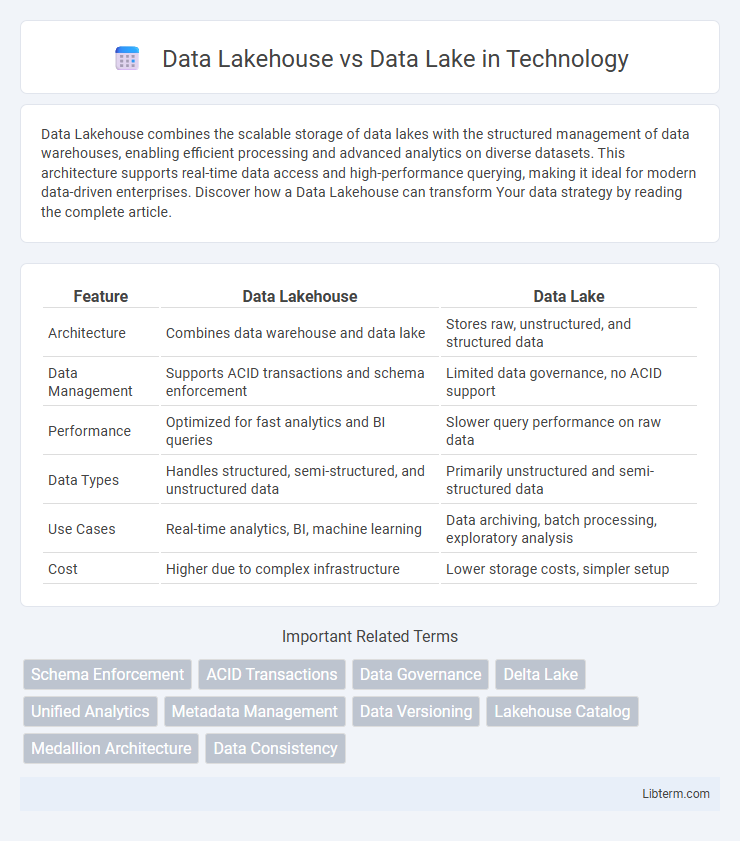Data Lakehouse combines the scalable storage of data lakes with the structured management of data warehouses, enabling efficient processing and advanced analytics on diverse datasets. This architecture supports real-time data access and high-performance querying, making it ideal for modern data-driven enterprises. Discover how a Data Lakehouse can transform Your data strategy by reading the complete article.
Table of Comparison
| Feature | Data Lakehouse | Data Lake |
|---|---|---|
| Architecture | Combines data warehouse and data lake | Stores raw, unstructured, and structured data |
| Data Management | Supports ACID transactions and schema enforcement | Limited data governance, no ACID support |
| Performance | Optimized for fast analytics and BI queries | Slower query performance on raw data |
| Data Types | Handles structured, semi-structured, and unstructured data | Primarily unstructured and semi-structured data |
| Use Cases | Real-time analytics, BI, machine learning | Data archiving, batch processing, exploratory analysis |
| Cost | Higher due to complex infrastructure | Lower storage costs, simpler setup |
Introduction to Data Lakehouse and Data Lake
Data Lakehouses combine the flexible storage of Data Lakes with the structured management and performance of Data Warehouses, enabling efficient data analytics and real-time processing. Data Lakes store vast amounts of raw, unstructured data in native formats, supporting large-scale data ingestion but often lack advanced data governance and query optimization. By integrating schema enforcement and transactional capabilities, Data Lakehouses address the limitations of Data Lakes while preserving scalability and cost-efficiency.
Core Concepts: What is a Data Lake?
A Data Lake is a centralized repository that allows storage of structured, semi-structured, and unstructured data at any scale, supporting raw data ingestion without requiring immediate schema definition. It enables flexible, cost-effective data storage and facilitates diverse analytics workloads, including batch processing and machine learning. Unlike traditional data warehouses, Data Lakes prioritize schema-on-read, allowing users to define schemas when data is accessed rather than when it is stored.
Core Concepts: What is a Data Lakehouse?
A Data Lakehouse combines the scalable storage of a Data Lake with the structured data management and performance optimization of a Data Warehouse, enabling unified analytics across diverse data types. It supports ACID transactions, schema enforcement, and governance, which address common limitations of traditional Data Lakes in data consistency and reliability. By integrating metadata management and open storage formats, a Data Lakehouse facilitates real-time data processing and advanced analytics on both structured and unstructured data.
Key Architecture Differences
A Data Lakehouse combines the flexible storage of a Data Lake with the robust data management and performance features of a Data Warehouse, using a unified architecture that supports both structured and unstructured data. It employs metadata layers and ACID transactions to ensure data reliability and governance, unlike traditional Data Lakes that often lack data consistency and schema enforcement. The Lakehouse architecture enables real-time analytics and BI workloads directly on raw data, whereas Data Lakes primarily serve as storage repositories requiring additional processing layers.
Data Management and Storage Capabilities
Data Lakehouse combines the flexible storage capabilities of a Data Lake with the structured data management and transactional support of a Data Warehouse, enabling efficient handling of both batch and real-time analytics. Data Lakes primarily store vast amounts of raw, unstructured data with limited schema enforcement, which can complicate data governance and quality control. Data Lakehouses enhance data management through unified metadata layers and ACID transactions, ensuring reliable, consistent, and optimized storage for diverse analytics workloads.
Performance and Query Optimization
Data Lakehouse combines the scalable storage of Data Lakes with the structured data management and ACID transactions of Data Warehouses, significantly enhancing query performance by enabling faster, more reliable data access. Unlike traditional Data Lakes, which often suffer from slow query speeds and lack of optimization, Data Lakehouses use indexing, caching, and data compaction techniques to improve query efficiency. These optimizations result in reduced latency and more efficient processing of complex analytics workloads across diverse data types.
Scalability and Flexibility
Data Lakehouses offer enhanced scalability by integrating data warehousing capabilities with traditional data lakes, enabling efficient management of both structured and unstructured data at scale. They provide greater flexibility through unified architecture that supports diverse analytical workloads, including batch and real-time processing, without compromising performance. In contrast, traditional Data Lakes excel in raw data storage but often struggle with scalability and flexible querying due to schema-on-read limitations and lack of optimized metadata management.
Security and Governance
Data Lakehouses integrate robust security frameworks combining data lake flexibility with data warehouse governance, enabling fine-grained access controls, encryption, and auditing capabilities. Unlike traditional data lakes, which often lack consistent governance and secure data management, data lakehouses enforce schema enforcement, data lineage tracking, and role-based access to ensure compliance with regulations such as GDPR and HIPAA. Enhanced security features in data lakehouses facilitate centralized policy enforcement, reducing data breaches and improving trust across enterprise analytics environments.
Use Cases: When to Choose Data Lake vs Data Lakehouse
Data lakes excel in storing vast amounts of raw, unstructured data for big data analytics and machine learning projects that require flexible schema-on-read processing. Data lakehouses combine the scalability of data lakes with the data management and transactional capabilities of data warehouses, making them ideal for business intelligence, real-time analytics, and scenarios demanding data reliability and governance. Organizations handling diverse, rapidly changing data with complex analytics benefit from data lakehouses, while pure data lakes suit exploratory, high-volume, and semi-structured data storage use cases.
Future Trends in Data Architecture
Data Lakehouse integrates the flexibility of Data Lakes with structured data management features of Data Warehouses, enabling advanced analytics and real-time processing, which is driving future trends in data architecture. Increasing adoption of AI and machine learning demands unified data platforms like Data Lakehouses to handle diverse data types and support scalable, low-latency queries. Emerging technologies such as cloud-native storage, metadata management, and open data formats will further enhance Lakehouse efficiency and interoperability, positioning it as the cornerstone of next-generation data ecosystems.
Data Lakehouse Infographic

 libterm.com
libterm.com